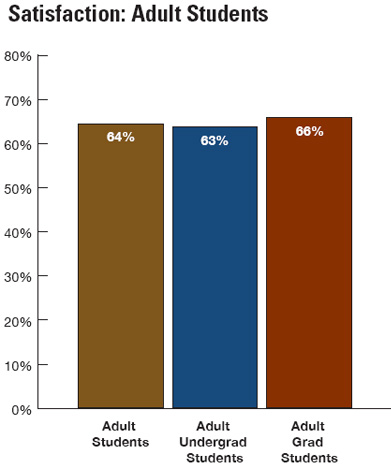student success
Are adult students on your campus really satisfied with their college experience?
I was interested in the recent blog about new government projections forecasting dramatic growth in college students 25 years of age and older. While just under 40 percent of college students currently fall in the nontraditional definition of 25 years of age and older, the proportion of students in this category is expected to skew higher as the decade progresses.
These statistics are interesting to note as we review the 2011 National Adult Student Satisfaction and Priorities Report, which reflects that adult students are generally satisfied with their experiences at four-year public and private institutions. As noted in the chart below, 64 percent of adult students are satisfied or very satisfied with their current college experience. This percentage is slightly lower for undergraduate adults and slightly higher for graduate-level adult students. All three categories are higher than the satisfaction percentage we see for traditional students at four-year private (57 percent) and four-year public (54 percent) institutions.

While adult students are generally satisfied with their college experience, when we take a closer look at the individual items that are rated with high importance and low satisfaction, we find six top challenges for institutions serving adult graduate and undergraduate students:
- Tuition paid is a worthwhile investment.
- I am able to register for classes I need with few conflicts.
- Faculty provide timely feedback about my progress.
- Adequate financial aid is available for most adult students.
- I seldom get the “run-around” when seeking information on this campus.
- There are sufficient options within my program of study.
The list of identified challenges for adult students is considerably shorter than the list of challenges identified for traditional students at four-year private and public institutions. This reinforces that adult-serving institutions are generally doing a good job of meeting adult students’ expectations, but the above six challenges remain critical areas for institutions serving adult learners. Colleges and universities with adult-serving programs have opportunities to communicate more strongly the value of the tuition students pay; to reduce “run-around” experiences; to create additional access to available classes; to encourage faculty to provide timely feedback about how students are performing in their classes; and to ensure that financial aid is available for nontraditional students. Many of these issues are similar to ones identified by traditional students, but the institutional responses may need to be targeted specifically to adult populations.
While it may be easy to point to the data that show adult learners as pretty satisfied students, I would suggest that if your adult students aren’t satisfied, they may not stay enrolled at your institution. Adult students in particular don’t have time to waste when they have other areas competing for their time and attention, such as work and family commitments. It is up to your institution to positively reinforce the value of the experience you are providing and to show a direct link to the adult students’ future opportunities at every step along their enrollment with you. I also encourage your institution to monitor closely the availability of your classes and to offer sufficient courses in popular areas. Otherwise you run the risk of adult students stopping out because they couldn’t get a required course one term.
These are just two ways you can influence adult student success for your institution. What initiatives do you have in place for your adult learners? Are you assessing adult students regularly to stay current with their priorities for improvement? Send me an e-mail and let me know.
